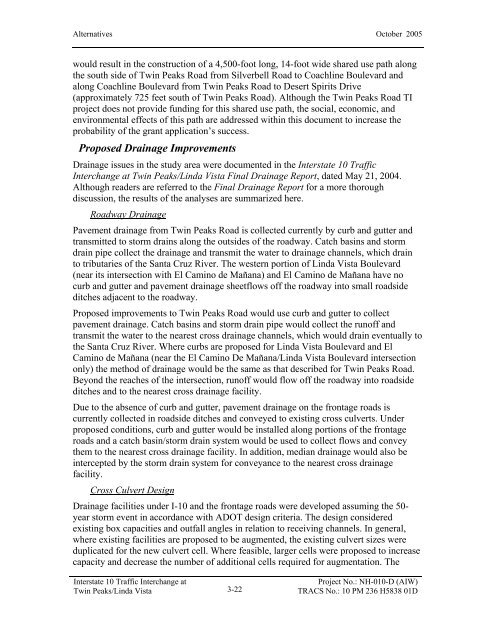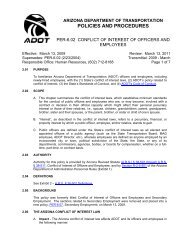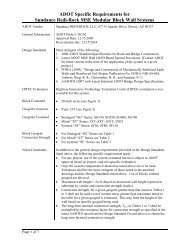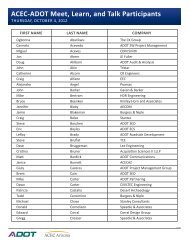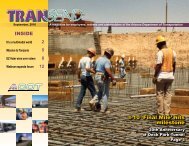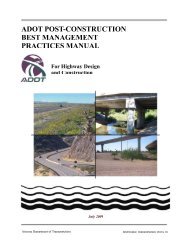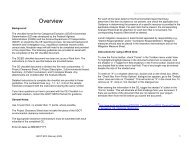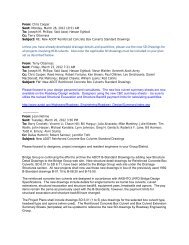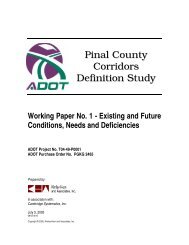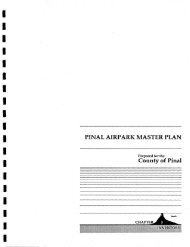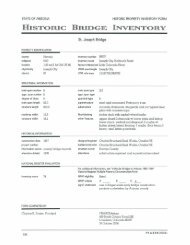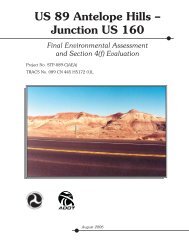I-10 Twin Peaks Traffic Interchange, Environmental Assessment
I-10 Twin Peaks Traffic Interchange, Environmental Assessment
I-10 Twin Peaks Traffic Interchange, Environmental Assessment
You also want an ePaper? Increase the reach of your titles
YUMPU automatically turns print PDFs into web optimized ePapers that Google loves.
Alternatives October 2005<br />
would result in the construction of a 4,500-foot long, 14-foot wide shared use path along<br />
the south side of <strong>Twin</strong> <strong>Peaks</strong> Road from Silverbell Road to Coachline Boulevard and<br />
along Coachline Boulevard from <strong>Twin</strong> <strong>Peaks</strong> Road to Desert Spirits Drive<br />
(approximately 725 feet south of <strong>Twin</strong> <strong>Peaks</strong> Road). Although the <strong>Twin</strong> <strong>Peaks</strong> Road TI<br />
project does not provide funding for this shared use path, the social, economic, and<br />
environmental effects of this path are addressed within this document to increase the<br />
probability of the grant application’s success.<br />
Proposed Drainage Improvements<br />
Drainage issues in the study area were documented in the Interstate <strong>10</strong> <strong>Traffic</strong><br />
<strong>Interchange</strong> at <strong>Twin</strong> <strong>Peaks</strong>/Linda Vista Final Drainage Report, dated May 21, 2004.<br />
Although readers are referred to the Final Drainage Report for a more thorough<br />
discussion, the results of the analyses are summarized here.<br />
Roadway Drainage<br />
Pavement drainage from <strong>Twin</strong> <strong>Peaks</strong> Road is collected currently by curb and gutter and<br />
transmitted to storm drains along the outsides of the roadway. Catch basins and storm<br />
drain pipe collect the drainage and transmit the water to drainage channels, which drain<br />
to tributaries of the Santa Cruz River. The western portion of Linda Vista Boulevard<br />
(near its intersection with El Camino de Mañana) and El Camino de Mañana have no<br />
curb and gutter and pavement drainage sheetflows off the roadway into small roadside<br />
ditches adjacent to the roadway.<br />
Proposed improvements to <strong>Twin</strong> <strong>Peaks</strong> Road would use curb and gutter to collect<br />
pavement drainage. Catch basins and storm drain pipe would collect the runoff and<br />
transmit the water to the nearest cross drainage channels, which would drain eventually to<br />
the Santa Cruz River. Where curbs are proposed for Linda Vista Boulevard and El<br />
Camino de Mañana (near the El Camino De Mañana/Linda Vista Boulevard intersection<br />
only) the method of drainage would be the same as that described for <strong>Twin</strong> <strong>Peaks</strong> Road.<br />
Beyond the reaches of the intersection, runoff would flow off the roadway into roadside<br />
ditches and to the nearest cross drainage facility.<br />
Due to the absence of curb and gutter, pavement drainage on the frontage roads is<br />
currently collected in roadside ditches and conveyed to existing cross culverts. Under<br />
proposed conditions, curb and gutter would be installed along portions of the frontage<br />
roads and a catch basin/storm drain system would be used to collect flows and convey<br />
them to the nearest cross drainage facility. In addition, median drainage would also be<br />
intercepted by the storm drain system for conveyance to the nearest cross drainage<br />
facility.<br />
Cross Culvert Design<br />
Drainage facilities under I-<strong>10</strong> and the frontage roads were developed assuming the 50year<br />
storm event in accordance with ADOT design criteria. The design considered<br />
existing box capacities and outfall angles in relation to receiving channels. In general,<br />
where existing facilities are proposed to be augmented, the existing culvert sizes were<br />
duplicated for the new culvert cell. Where feasible, larger cells were proposed to increase<br />
capacity and decrease the number of additional cells required for augmentation. The<br />
Interstate <strong>10</strong> <strong>Traffic</strong> <strong>Interchange</strong> at<br />
<strong>Twin</strong> <strong>Peaks</strong>/Linda Vista<br />
3-22<br />
Project No.: NH-0<strong>10</strong>-D (AIW)<br />
TRACS No.: <strong>10</strong> PM 236 H5838 01D


